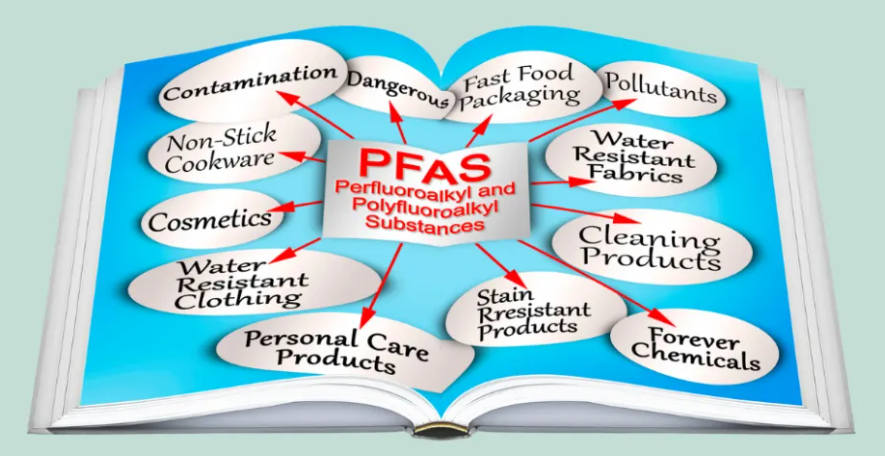Understanding ‘Forever Chemicals’: The PFAS Concern (GS Paper 3, Science & Technology)

What Are PFAS?
- Per- and polyfluoroalkyl substances (PFAS), often referred to as “Forever Chemicals,” are a large group of synthetic chemicals characterized by their carbon-fluorine bonds, which make them highly resistant to environmental degradation.
- This resistance contributes to their persistence in the environment and human body, earning them the nickname "Forever Chemicals."
Common Uses of PFAS
PFAS are utilized in a wide range of consumer products due to their unique properties, including:
- Non-stick Cookware: PFAS are used to create coatings that prevent food from sticking, making cooking and cleaning easier.
- Water-Repellent Fabrics: These chemicals are found in outdoor clothing, upholstery, and carpets, providing water resistance and stain repellency.
- Food Packaging: PFAS can be present in fast-food wrappers, microwave popcorn bags, and pizza boxes, helping to resist grease and oil.
- Firefighting Foam: Certain types of PFAS are used in firefighting foams, particularly in aviation and military applications, to combat flammable liquid fires.
Despite some PFAS being phased out or banned, many variants continue to be produced and used, contributing to ongoing environmental and health concerns.
Health Implications of PFAS Exposure
Research has increasingly linked PFAS exposure to a variety of health problems. Key health effects include:
- Immune System Impairment: PFAS can weaken the immune response, potentially reducing vaccine effectiveness and increasing susceptibility to infections.
- Liver Damage: Studies suggest that PFAS exposure can lead to liver disease and changes in liver enzymes.
- Reproductive Issues: PFAS exposure has been associated with lower birth weights and developmental issues in infants.
- Cancer Risk: Some studies have found correlations between PFAS exposure and an increased risk of certain cancers, including kidney and testicular cancer.
The mechanisms through which PFAS affect health are still being researched, but their ability to accumulate in the body and persist in the environment raises significant concerns.
Recent Study Findings on PFAS in Drinking Water
A study conducted by researchers from the University of Birmingham and Hainan University highlighted the prevalence of PFAS in drinking water across various locations, including the UK and China.
Study Methodology:
- Researchers collected a total of 153 water samples, including:
- 112 bottled water samples from various shops in the UK and China (both still and sparkling).
- 41 tap water samples from cities in the UK (Birmingham, Worcester, Coventry, and Derby).
- 14 samples from Shenzhen, China.
Key Findings:
- Widespread Contamination: Over 99% of bottled water samples contained significant levels of PFAS, particularly PFOA and PFOS.
- Variability in PFAS Levels: Bottled water exhibited variability in PFAS concentrations. Purified water generally had lower levels compared to natural mineral water, which often contained higher PFAS concentrations.
- Concerns in Tap Water: Tap water samples from Shenzhen showed alarming levels of PFAS, with some exceeding the U.S. EPA’s maximum contaminant level of 4 ng/L.
Health Advisory Levels for PFAS
Regulatory agencies like the U.S. Environmental Protection Agency (EPA) set health advisory levels for PFAS to guide public safety and protect against potential health risks. The study found that:
- Bottled Water Compliance: Most bottled water samples generally met health advisory levels, suggesting they were safe for consumption.
- Tap Water Risks: Conversely, certain areas, especially in China, had tap water with PFAS concentrations that posed a higher health risk, highlighting a significant public health concern.
Effective Methods to Reduce PFAS Exposure
To mitigate PFAS levels in drinking water, several practical solutions can be implemented:
- Boiling Water: While boiling can reduce some levels of PFAS, it is not a comprehensive solution, as it may not eliminate these chemicals entirely.
- Carbon Filtration Systems: Activated carbon filters are effective in removing up to 90% of PFAS from drinking water. These systems are increasingly being used in homes and water treatment facilities.
Professor Stuart Harrad emphasized that relatively simple treatment solutions can dramatically reduce PFAS levels, making water safer for everyday use.
Public Health Implications
The findings of widespread PFAS contamination in drinking water have critical implications for public health. Increased awareness of the associated risks may lead consumers to:
- Seek Alternative Water Sources: Consumers may start using filtered or bottled water to minimize exposure.
- Advocate for Better Regulations: Public concern can drive demand for stricter regulations governing the use of PFAS in consumer products and water treatment practices.
Significance of Ongoing Research
The study highlights the urgent need for continued research on PFAS and its health impacts. Key areas for future investigation include:
- Long-Term Health Effects: Understanding the chronic effects of PFAS exposure on various populations.
- Environmental Monitoring: Ongoing assessment of PFAS levels in water sources to inform public health interventions.
- Development of Mitigation Strategies: Creating effective strategies to address PFAS contamination in drinking water supplies and developing alternative substances.
Conclusion
- The detection of PFAS in drinking water underscores a significant public health challenge that requires immediate attention.
- As awareness of the risks associated with these "Forever Chemicals" grows, it can catalyze demand for improved water treatment technologies and more stringent regulatory measures.
- Continued research is essential for understanding the long-term implications of PFAS exposure and for developing effective strategies to protect public health and the environment.
- Through concerted efforts, it may be possible to mitigate the risks associated with these persistent chemicals and ensure safer drinking water for all.


